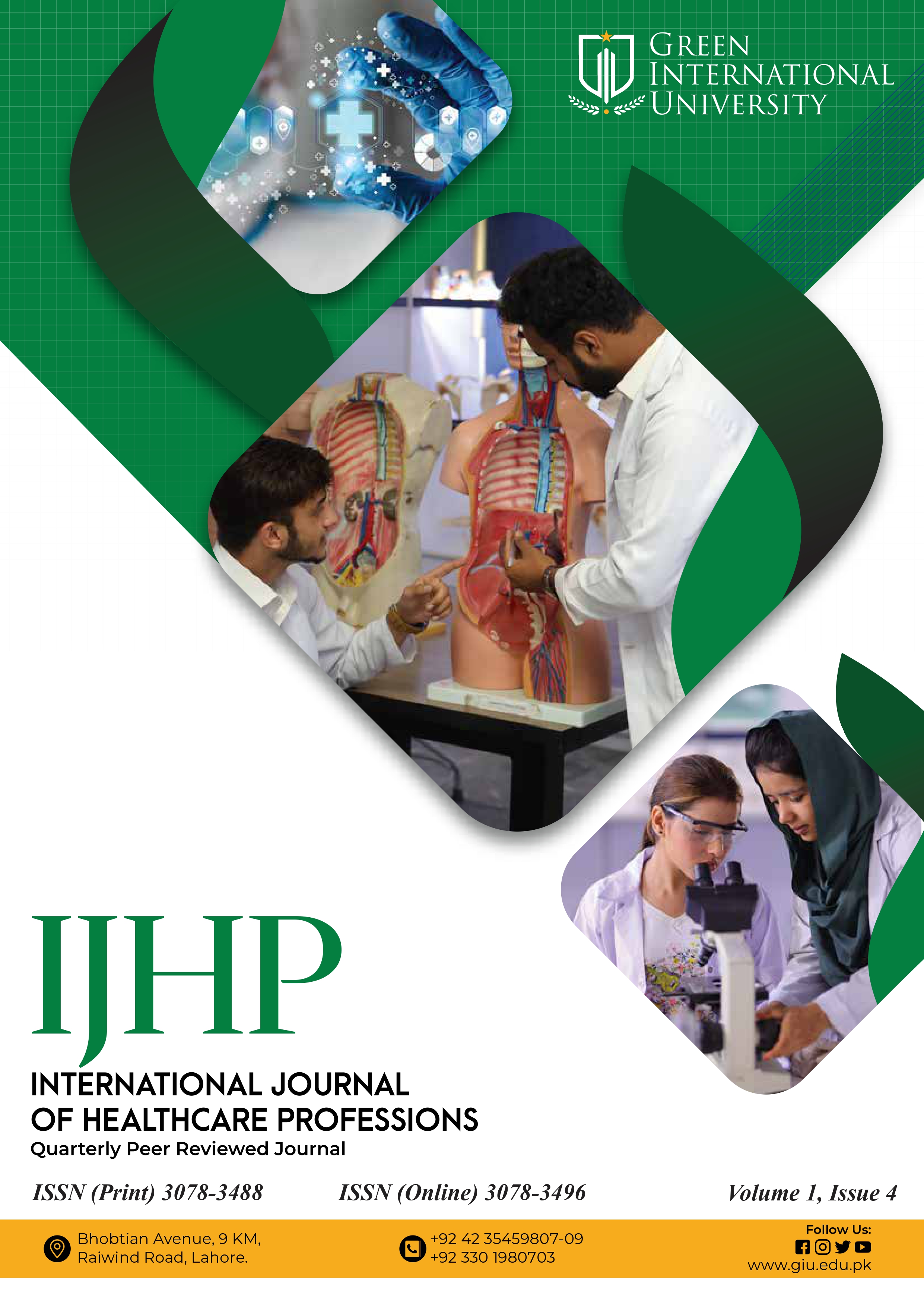Spectrum of Interstitial Lung Disease at Tertiary Care Hospital in Lahore
DOI:
https://doi.org/10.71395/ijhp.1.4.2024.31-35Abstract
Background and Objectives: Interstitial lung disease (ILD) is a family of lung diseases characterized by inflammation and scarring of the lung tissue, alveolar walls, alveolar ducts, and bronchioles. The nature of such diseases is rather diverse, and they can be caused by any number of factors of manifest different progression patterns; thus, correct diagnosis is crucial here. To compare the range of ILDs among patients admitted to a tertiary care hospital in Lahore.
METHODOLOGY: This cross-sectional study recruited 149 patients (121 male and 30 female) with suspected ILD using a convenient sampling technique from General Hospital Lahore. These symptoms were cough in 99 patients, shortness of breath in 112 patients and smoking in 97 patients. The diagnosis was done using HRCT through a Toshiba Aquiline 64 Slice CT scanner.
RESULTS: Out of the 149 patients, 99 had cough, 112 had short breath, and 97 were smokers. The HRCT results showed that the middle right lung lobe was involved in 44%, the upper lung zone in 52% and the lower lung zone
in 53% of smokers. There was a slight increase in Septal thickening (33%) and focal to moderate honeycombing (35%) in the upper left lobe. The ages ranged from 48 to 73 years.
CONCLUSION: The findings of this study show that ILDs are more prevalent in females as compared to males. The common symptoms of ILDs are similar to tuberculosis, which suggests that the disease remains grossly unrecognized and underdiagnosed. Some drugs, including chemotherapeutic agents and anti-inflammatory drugs, have been found to induce the formation of ILD.
References
Sula I, Alreshidi MA, Alnasr N, Hassaneen AM, Saquib N. Urinary tract infections in the Kingdom of Saudi Arabia, a review. Microorganisms.
;11(4):952.
Lindén M, Rosenblad T, Rosenborg K, Hansson S, Brandström P. Infant urinary tract infection in Sweden—A national study of current diagnostic
procedures, imaging and treatment. Pediatric Nephrology. 2024;39(11):3251-62.
Alsaywid BS, Alyami FA, Alqarni N, Neel KF, Almaddah TO, Abdulhaq NM, et al. Urinary tract infection in children: A narrative review of clinical practice guidelines. Urology Annals. 2023;15(2):113-32.
Saddari A, Benhamza N, Dalli M, Ezrari S, Benaissa E, Lahlou YB, et al. Urinary tract infections older adults at Mohammed VI University Hospital of Oujda: case series. Annals of Medicine and Surgery. 2023;85(5):1408-12.
Harb A, Yassine V, Ghssein G, Salami A, Fakih H. Prevalence and clinical significance of urinary tract infection among neonates presenting with unexplained hyperbilirubinemia in Lebanon: A retrospective
study. Infection & Chemotherapy. 2023;55(2):194.
Huang L, Huang C, Yan Y, Sun L, Li H. Urinary tract infection etiological profiles and antibiotic resistance patterns varied among different age categories: a retrospective study from a tertiary general hospital during 12 years. Frontiers in microbiology. 2022;12:813145.
Komagamine J, Yabuki T, Noritomi D, Okabe T. Prevalence of and factors associated with atypical presentation in bacteremic urinary tract infection.
Scientific reports. 2022;12(1):5197.
Gozdzikiewicz N. Zwoli nska, D.; Polak-Jonkisz, D. The Use of Artificial Intelligence Algorithms in the Diagnosis of Urinary Tract Infections—A Literature Review. Pediatric and Adolescent Nephrology Facing the Future. 2022;11:265.
Shaki D, Hodik G, Elamour S, Nassar R, Kristal E, Leibovitz R, et al. Urinary tract infections in children< 2 years of age hospitalized in a tertiary medical centre in Southern Israel: epidemiologic, imaging, and microbiologic characteristics of the first episode in life. European Journal of Clinical
Microbiology & Infectious Diseases. 2020;39:955-63.
Isert S, Müller D, Thumfart J. Factors associated with the development of chronic kidney disease in children with congenital anomalies of the kidney
and urinary tract. Frontiers in Pediatrics. 2020;8:298.
Amoori P, Valavi E, Fathi M, Sharhani A, Izadi F. Comparison of Serum Zinc Levels Between Children With Febrile Urinary Tract Infection and Healthy Children. Jundishapur Journal of Health Sciences. 2021;13(3).
Suresh J, Krishnamurthy S, Mandal J, Mondal N, Sivamurukan P. Diagnostic accuracy of point-of-care nitrite and leukocyte esterase dipstick test for the screening of pediatric urinary tract infections. Saudi Journal of Kidney Diseases and Transplantation. 2021;32(3):703-10.
Swamy SNN, Jakanur RK, Sangeetha SR. Significance of C-reactive protein levels in categorizing upper and lower urinary tract infection in adult patients. Cureus. 2022;14(6).
Esposito S, Maglietta G, Di Costanzo M, Ceccoli M, Vergine G, La Scola C, et al. Retrospective 8-year study on the antibiotic resistance of uropathogens in children hospitalised for urinary tract infection in the Emilia-Romagna Region,
Italy. Antibiotics. 2021;10(10):1207.
Vachvanichsanong P, McNeil E, Dissaneewate P. Extended-spectrum beta-lactamase Escherichia coli and Klebsiella pneumoniae urinary tract
infections. Epidemiology & Infection. 2021;149:e12.
Kamei J, Yamamoto S. Complicated urinary tract infections with diabetes mellitus. Journal of Infection and Chemotherapy. 2021;27(8):1131-6.
Raghu, G., Remy-Jardin, M., Myers, J.L., Richeldi, L., Cottin, V., Danoff, S.K., Morell, F. Flaherty, K.R., Brown, K.K., Wells, A.U. and Devaraj, A., 2020. Diagnosis of idiopathic pulmonary fibrosis. An official ATS/ERS/JRS/ALAT clinical practice guideline. American Journal of Respiratory and Critical Care Medicine, 198(5),
pp.e44-e68.
Mukhtar, M., Anwar, M.M., Adnan, M., Aziz, S. and Hafeez, S., 2019. Clinical and radiological spectrum of interstitial lung diseases at a tertiary care hospital in Pakistan. Pakistan Journal of Medical Sciences, 35(2), pp.412-417.
Fischer, A. and Distler, J., 2019. Progressive fibrosing interstitial lung disease associated with systemic autoimmune diseases. Clinical Rheumatology,
(10), pp.2673-2681.
Mahmood, K., Ahmed, M., Arshad, A., Hussain, S. and Saeed, F., 2021. High-resolution computed tomography patterns in interstitial lung disease:
Experience from a tertiary care hospital in Lahore. Journal of the College of Physicians and Surgeons Pakistan, 31(8), pp.918-922.
Downloads
Published
Issue
Section
License
Copyright (c) 2025 International Journal of Healthcare Professions

This work is licensed under a Creative Commons Attribution 4.0 International License.
This is an open-access journal and all the published articles / items are distributed under the terms of the Creative Commons Attribution License, which permits unrestricted use, distribution, and reproduction in any medium, provided the original author and source are credited. For comments ijhp@giu.edu.pk






